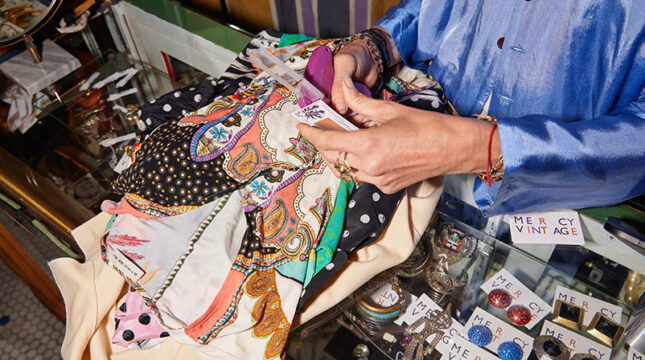1. Decide which handmade crafts you’ll sell
From homemade candles to handmade jewelry, there’s no shortage of artisan creations for sale on the internet these days. However, if you’re dreaming of growing a business and creating a lucrative endeavor, you need to treat it like a business instead of a hobby.
Your first thing to do when starting a craft business is determining what items you will sell, if there’s a market for it and how you will differentiate yourself from others selling similar products.
For example, you may love making candles, but many businesses already sell them. So, you might specialize in selling non-toxic varieties made from beeswax.
When you’re getting started, limiting the types of products you sell helps minimize the supplies you need, which can save you money while you’re ramping up.
2. Put together a business plan
A business plan is a document that provides an overview of your company. It acts as a roadmap to help you stay on track to achieve your goals.
Your plan can include as much or as little detail as you want. However, if you plan to grow really big and apply for funding to get your business off the ground, lenders usually want to see a more detailed plan.
If you don’t know how to create one, there are lots of online templates you can use to guide you. Key components of most business plans include:
- Executive summary
- Company description
- Products and services
- Market analysis
- Financial projections
- Marketing plan
3. Choose a business structure for your crafting business
How you set up your company affects your taxes. If you’re a one-person shop, the simplest way to get started is as a sole proprietor. However, when you start a business as a sole proprietor, there’s no separation between your personal and business assets. So, your personal finances could be at risk if someone sues you.
A popular alternative to a sole proprietorship is an LLC. What’s the difference? Setting up your business as an LLC limits your personal legal responsibility, helping to protect your personal assets. You can establish LLCs with as few or as many members as you want.
If you’re starting a craft business with someone else, you may consider a partnership, where each person assumes some of the risks and receives a share of the profits.
A final option is to register your business as an S Corporation. This business structure allows you to become incorporated without being taxed twice the way larger corporations are. Depending on how much you earn, S Corps may also have some tax advantages over other options.
There’s a lot to consider when deciding how to structure your business. You may want to speak with a tax professional or business attorney who can advise you on the pros and cons of each option and help you make the decision that’s best for you.
4. Buy insurance to protect your craft business
Having adequate insurance coverage can help protect your craft business from common ecommerce risks and a financial loss. Here are common types of insurance you may need.
- General liability. This type of coverage helps protect you from non-employee injuries and property damage.
- Product liability. This coverage helps protect your small business from having to pay for legal fees if a customer says that an issue with your product caused them injury or property damage.
- Commercial property. Commercial property insurance helps pay to replace your inventory, supplies and equipment if they are damaged, destroyed or malfunctioning. It can also help replace your income if you need to temporarily suspend your business operations due to a covered loss.
- Workers’ compensation. If you plan on going solo initially, you won’t need this type of coverage to start. But if your orders grow to the point where you need to bring in some help to keep up, you’ll likely need it. Many states require businesses with one or more employees to maintain workers’ compensation coverage.
It’s also a good idea to check with your homeowner’s insurance company. You should find out if operating a business out of your home will affect your coverage and what, if any, business-related damages your policy may cover.
5. Acquire licenses and permits
License and permit requirements vary by location and what you sell, so it’s important to check with your state and city or town to find out what you need. Certain places may require you to have a permit or license if you sell your goods in brick-and-mortar locations; online platforms and marketplaces may have their own requirements, so it’s best to check.
Regardless of where your business is located, here are some licenses and permits that are commonly required.
- Business license. Nearly all businesses in the United States need a business license to operate legally.
- Employee Identification Number (EIN). Sole proprietors and some single-member LLCs aren’t required to have an EIN. But you can get one if you want. Partnerships, corporations and some LLCs must obtain an EIN from the IRS for tax purposes.
- Seller’s permit. When you’re selling goods instead of services, you typically need a seller’s permit so the government can collect sales tax on the items you sell. Some states charge a nominal fee — typically less than $100 — for this type of permit, but most don’t charge anything.
6. Build your ecommerce site
Now that you know what you’re going to sell, you need to decide where you will sell your handmade crafts. Will you use an instantly recognizable online marketplace like Amazon or Etsy that’s already done most of the heavy lifting for you, so you can begin listing your products immediately?
Or will you create a full-blown ecommerce website using a platform like Shopify, WooCommerce or BigCommerce that requires more legwork but allows you to create a fully customized site with your own branding and domain name?
There are pluses and minuses to both options, so it’s worth doing some research before making your decision.
7. Choose your vendors
There’s nothing wrong with heading to the dollar store to get crafting supplies for your kindergartener’s Halloween party. But that strategy won’t work when you’re building a crafting business and scaling up.
Start off on the right foot by establishing relationships with vendors who provide the high-quality materials your customers expect. Make sure they’re reliable so there are no nasty surprises when you need to replenish your supplies.
Depending on the number of sales you expect to complete each month, consider seeking out vendors that offer volume discounts to help you save some money.
8. Brush up on your photography skills
Having high-quality photos of your products on your site is essential to maximizing sales of your handmade crafts. When they can’t see an item in person, people rely on images to make online purchasing decisions. Make sure you have good lighting and take photos from multiple angles to give the most accurate representation of your creations as possible.
No one wants to order a beaded bracelet that looks purple and white in the photo only to find out that it’s actually navy blue and pale pink when it arrives at their door.
9. Promote your craft business
You’re not a multi-million-dollar corporation, and you don’t need to be one to be successful. Many people prefer to support small businesses over large corporations, and some are willing to pay more to do it. People like to buy from people they can relate to, so don’t be afraid to show off your personality in your marketing.
Here are some ways you can get the word out about your business.
- Social media. Whether it’s TikTok, Pinterest, Instagram or Facebook, post information about your business on channels where your target customers hang out.
- Email. Not only is email not dead, but it’s one of the most cost-effective marketing tools available. Start building your list so you can keep in touch with customers and prospects. Be sure to balance promotional content with informational/educational content.
- Online advertising. Consider a targeted paid advertising campaign to get your message in front of potential customers.
- Share your knowledge. Dip your toe into the public relations waters and become an expert resource for journalists, bloggers and business writers looking for interview sources







